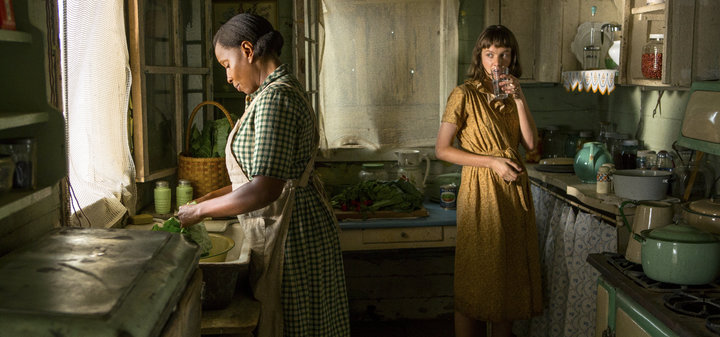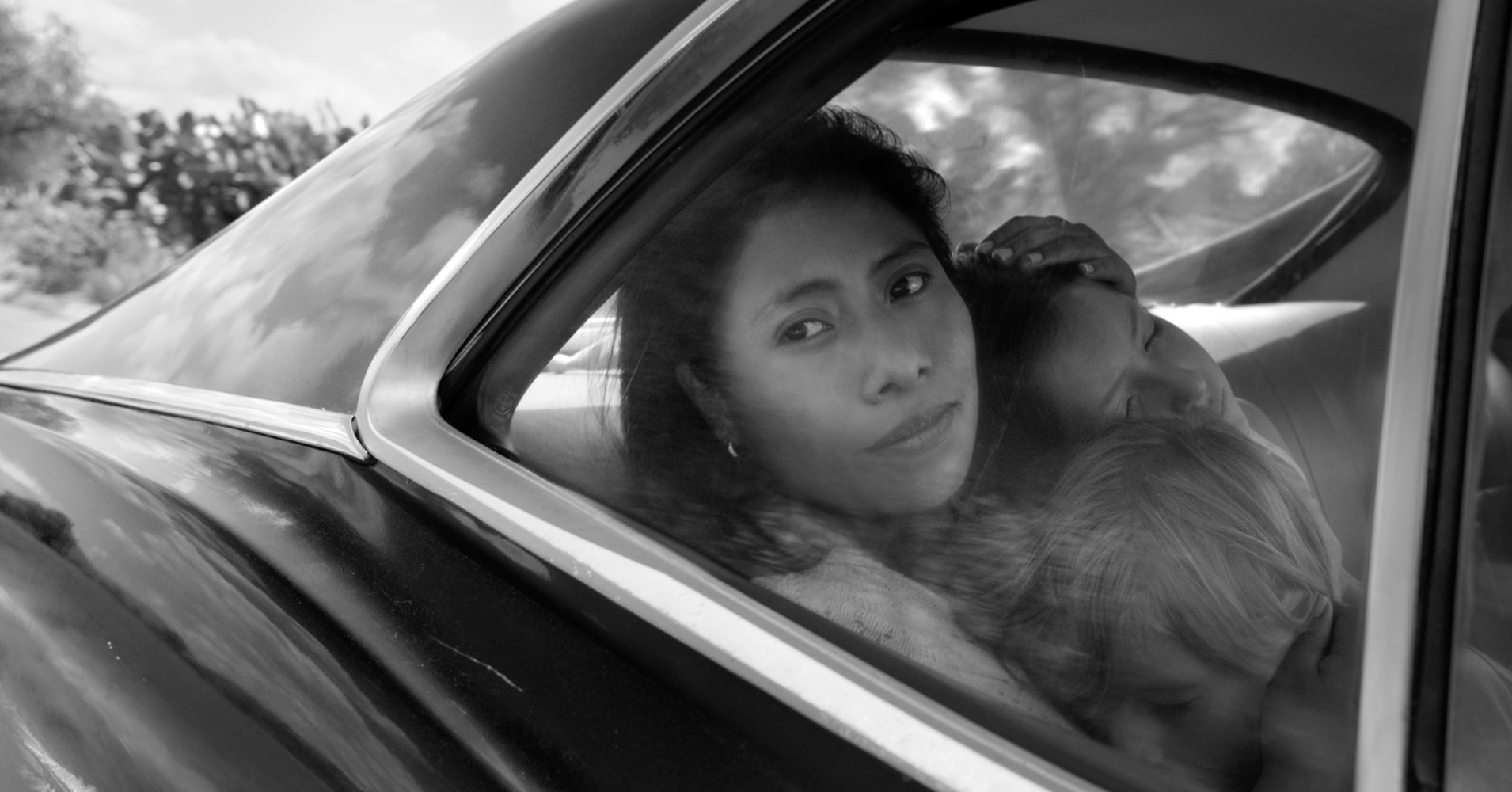[ad_1]
The new movie “Roma” hit Netflix on Friday, tying the knot between the world’s eminent streaming platform and one of cinema’s most accomplished directors.
An affecting drama about an indigenous housekeeper in early-1970s Mexico City, the latest from Alfonso Cuarón (“Children of Men,” “Harry Potter and the Prisoner of Azkaban”) is set to become background noise for millions of subscribers sipping eggnog and wrapping holiday gifts this weekend. That’s what Netflix is for, right?
For those who are more invested in Cuarón, or quality movies in general, “Roma” is also a top-tier Oscar contender, likely to earn a Best Picture nomination and give the auteur a second shot at a Best Director trophy (after his previous win for “Gravity”). And that’s exactly why its placement on Netflix has proven controversial.
To quality for the Oscars, a movie has to be released theatrically. But Netflix enforces unconventional strictures around how its originals are exhibited on the big screen, placing the streamer at odds with the country’s top theater chains and shrouding the films in spotty PR. This war has been raging ever since Netflix revved up its quest for cultural domination a few years ago.
It has only grown more contentious amid the “Roma” rollout, so now is a good time to catch up on what it all means. The details are multifaceted, but I’m here to offer an overview of what led Netflix to its Cuarón-related hiccups.
Why is anyone up in arms about Netflix?
Netflix upended the TV game in 2013 when “House of Cards” and “Orange Is the New Black” debuted to much fanfare and went on to collect a bevy of Emmy nominations. Suddenly, every network ― and every nascent streaming competitor ― faced fierce competition in Netflix. The term “peak TV” was born, and the overwhelming glut of content that came with it has steadily proliferated.
Now the streaming giant threatens to transform the theatrical experience, which by the early 2010s had mutated into a marketplace overrun by franchises.
Netflix established its commitment to original movies in 2015, ponying up a hefty $12 million for the Cary Fukunaga war drama “Beasts of No Nation,” starring Idris Elba and newcomer Abraham Attah. Traditionally, major theater chains (think AMC, Regal, Cinemark, Carmike) get a 90-day exclusivity period on new films, preventing competition from DVDs, digital rentals and the like. But when “Beasts” bowed that October, Netflix demanded what is known as a “day-and-date release,” meaning the movie would premiere on the app the same day it hit multiplexes.
The aforementioned chains therefore declined to show the film, setting in motion a beef between Netflix and the long-established Hollywood infrastructure ― a conflict that has escalated as the platform’s original-content programming budget stretches further and further into the billions.

Netflix
“Beasts” screened only in small art-house venues, collecting a piddly $90,777. To be fair, part of that low sum might be attributable to the movie’s heavy subject matter. Still, it wasn’t a great look for Netflix, which had positioned “Beasts” as an Oscar candidate via premieres at major festivals that fall.
“The box office for ‘Beasts of No Nation’ is not surprising because Netflix had no faith in its commercial theatrical prospects and put no effort into its theatrical success,” National Association of Theater Owners vice president Patrick Corcoran said at the time. “It was merely PR for the home video, which is usually the only point of simultaneous release.”
Netflix’s data-averse content chief, Ted Sarandos, on the other hand, bragged that “Beasts” was streamed more than 3 million times in North America during its first week. According to its own logic, if Netflix could muster Oscar nominations, it would emerge the clear victor. Alas, “Beasts” was left off that year’s Oscar roster, signaling that, like the theater conglomerates, the Academy of Motion Picture Arts and Sciences might not be ready to embrace the streaming age.
After the “Beasts” debacle, Netflix stopped making its movies’ profits public. When the Netflix-backed “Crouching Tiger, Hidden Dragon” sequel opened theatrically in March 2016, its revenue appeared on the box-office reporting service comScore, as any movie’s would ― and then, according to The Hollywood Reporter, it suddenly disappeared, effectively retracted by Netflix.
“When you release a film in theaters, whether the results are good or bad, it’s customary to report grosses,” Jeff Bock, senior analyst at the influential entertainment data firm Exhibitor Relations, said. “With a sequel of this magnitude, it’s a shock that Netflix did not issue numbers, which can only mean they were pedestrian at best, terrible at worst.”
In the end, the whole “Beasts” and “Crouching Tiger” ordeal created iffy optics for Netflix’s integrity, even if most of the platform’s 130 million subscribers don’t pay attention to industry dynamics.
Has Netflix’s relationship with the major theater chains improved?
For the most part, Netflix only attempts theatrical releases when it wants a movie to compete for Oscars. After all, the platform’s subscription-based business model is built on living-room viewership; the company has little to gain from letting you see its content on the big screen. But Netflix’s top brass knows that a traditional studio’s esteem is tallied in televised awards, and no matter how many subpar films they scoop up, it’s obvious the enterprise wants to be counted as a cultural tastemaker.
As has long been the case, to qualify for the Oscars a movie must play at a Los Angeles theater for at least seven consecutive days without being distributed or broadcast elsewhere beforehand. As a result, Netflix tends to push its strongest offerings ― things like “Okja,” “Mudbound” and “The Meyerowitz Stories (New and Selected)” ― into theaters the same day they premiere digitally. That means that of the dozens of original movies Netflix now releases each year, only the best find themselves shrouded in accompanying PR woes.
The most notable of these is “Mudbound,” another heavy drama that Netflix targeted as an awards darling. After acquiring Dee Rees’ period piece for $12.5 million at Sundance in January 2017, Netflix hired awards-campaign veteran Julie Fontaine as its head of motion-picture publicity. It also enlisted top-shelf Oscar strategists Cynthia Swartz and Lisa Taback to help plot an Academy crusade.
Of course, when “Mudbound” opened to critical acclaim on 17 screens that November, Netflix again declined to report grosses. And behind the scenes, some Academy voters still questioned whether a movie showcased primarily on small screens was worthy of Hollywood’s big-screen accolades.

Netflix
But the in-house strategizing paid off. “Mudbound” eventually earned four Oscar nominations, including a coveted acting nod for Mary J. Blige. The establishment suddenly seemed less resistant to sacrificing the purity of the theatrical experience ― sorry, Christopher Nolan! ― even if Netflix’s relationship with the chains hadn’t improved.
Which brings us to “Roma.”
What does this have to do with “Roma”?
As soon as Netflix snagged “Roma” in April for a reported $20 million, it was clear that Alfonso Cuarón’s dreamy black-and-white mood piece would be its premier Oscar pony. It was also clear that the acquisition would be rife with drama.
Following an impasse with Cannes Film Festival organizers that resulted in the film being pulled from the lineup, Netflix agreed in October, for the first time, to bend its day-and-date strictures to give “Roma” theatrical exclusivity ― but only to a degree. By that point, the streamer had hired Taback and her team as full-time awards schemers. (A true warhorse, Taback worked on the campaigns for Best Picture winners like “Shakespeare in Love,” “Chicago,” “The King’s Speech” and “Moonlight.”)
Netflix granted Cuarón’s film three weeks’ exclusivity, meaning it would enjoy a wider footprint but still not satisfy the major chains’ 90-day expectation. (It also gave the Coen brothers’ “The Ballad of Buster Scruggs” and the Sandra Bullock thriller “Bird Box” one week of exclusivity apiece, for whatever that’s worth.)
“This halfway gesture will fail to satisfy theatrical audiences, filmmakers and Netflix subscribers,” the National Association of Theatre Owners said in a statement in response. “Netflix has yet to learn that it isn’t theatrical vs. streaming ― it’s theatrical and streaming, properly sequenced.”

Netflix
The good news: At its peak, “Roma” would play at least 100 domestic theaters and 500 international theaters ― far more than “Beasts of No Nation” or “Mudbound.” The bad news: Despite those numbers, Netflix started sparring with independent theater owners, too.
Alamo Drafthouse, one of the country’s most prominent independent chains, with 35 locations nationwide, reportedly tried to negotiate a way to show the film, but it couldn’t accommodate Netflix’s technical guidelines. Those included screening the film in 70mm and letting Netflix rent auditoriums from Drafthouse instead of splitting profits the standard way. Other venues couldn’t adhere to the Dolby Atmos Surround Sound requirements that Netflix imposed. Rather than budge, Netflix sacrificed those theaters, again leaving the impression that it did not play well with the establishment.
Perhaps more glaringly, Cuarón expressed disappointment over Netflix’s inability to book more theaters in his home country of Mexico. The director didn’t outright blame Netflix, but it doesn’t take much to read between the lines: The reason “Roma” isn’t more available is at least somewhat because Netflix wouldn’t postpone the movie’s streaming premiere to allow for the 90-day exclusivity window that Mexico’s biggest theater chain, Cinepolis, has long required.
“I would like many more theatrical engagements in Mexico,” Cuarón said on Twitter. “We have all the theaters we have been able to get, which sadly is 40. To put that in perspective, Poland will exhibit in 57 halls and South Korea in 50. ‘Roma’ is available to all cinemas who want to exhibit it.”
When “Roma” opened Nov. 21 on three screens in New York and Los Angeles, Netflix again refused to report its grosses. But industry sources reportedly told Deadline that sold-out showings contributed to a healthy $200,000 intake, something Netflix should want to boast about, as that sort of limited-release boon signals a potential win in wide release.
The question remains, however: How will all of these dynamics translate to the Oscars when nominations are announced Jan. 22? Assuming enough of the Academy’s roughly 8,000 members have warmed to the streaming scene, it could yield Netflix’s inaugural Best Picture nomination, as first suggested by the movie’s rapturous reviews out of fall’s pacesetting festivals. It helps that “Roma” has been a staple among critics’ year-end prizes and racked up three Golden Globe nominations last week.
Furthermore, Cuarón ― more so than Cary Fukanaga and Dee Rees, who are significantly younger ― is a beloved veteran with six Oscar nominations to his name. He alone could be enough to get voters to overlook lingering Netflix hangups, at least for the time being. But that does nothing to stymie the battles Sarandos and company have waged with the larger distribution ecosystem.
Why should we care about any of this?
For better and worse, Netflix plays a larger role in Hollywood by the day. When 2018 ends, the platform will be able to claim around 1,000 original series, movies and specials altogether. That overwhelming bulk contributes to the sense that the contemporary entertainment landscape is overrun with content, much of it middling at best. The trajectory will only continue as Netflix and its competitors take more and more movies away from theaters. (Even Martin Scorsese’s next project is for Netflix.)
There’s nothing wrong with watching movies at home, especially since multiplexes aren’t dedicated to high-brow fare and theater ticket prices have become untenable for many people. But Netflix’s release strategy, even when it eases up on day-and-date rules, reeks of cynicism, especially since Sarandos fancies himself a cinephile. The company doesn’t care about presenting the best entertainment to the widest possible audience; it only cares about maintaining subscribers and basking in the glory of potential awards.
Movies smaller or less prestigious than “Roma” often receive minuscule marketing efforts ― if they’re marketed at all ― and end up falling into the void, shortchanging everyone who made them and everyone who might want to see them. (Take, for example, “I Don’t Feel at Home in This World Anymore,” a Sundance prizewinner that was largely forgotten as soon as it debuted last year.) And when Netflix does have something like “Roma” or “Mudbound” on its hands, that film gets mired in petty squabbles.
In the end, Netflix is waging an unnecessary war with theater owners at a time when non-franchise movies are underperforming at unprecedented rates. Netflix could retool its strategy if it wanted to. Just look at Amazon, which grants full theatrical exclusivity before its titles hit the streaming site ― a strategy that has benefited “Love & Friendship,” “Manchester by the Sea,” “I Am Not Your Negro,” “The Big Sick,” “Beautiful Boy” and more. Amazon has a symbiotic relationship with traditional distributors, whereas Netflix routinely makes headlines for polarizing business moves.
The preservation of movies in America depends on the evolution of the streaming age. Is Netflix the moral enemy that some cinema purists insist it is? Maybe not. But it is making needless enemies in the industry, despite having already amassed cultural magnitude. Those conflicts don’t benefit theaters looking to book something other than superhero behemoths, nor do they serve consumers or filmmakers.
Netflix claims to be a more-is-better buffet when it is actually an opportunistic snack bar: The quality is spotty, and the customer relations leave something to be desired. The median quality of Netflix’s content, in both features and series, is faltering. The least it could do is treat its best titles ― say, “Roma” ― with the dignity they deserve, rather than see them as showboats racing for a shiny prize.
[ad_2]
Source link

